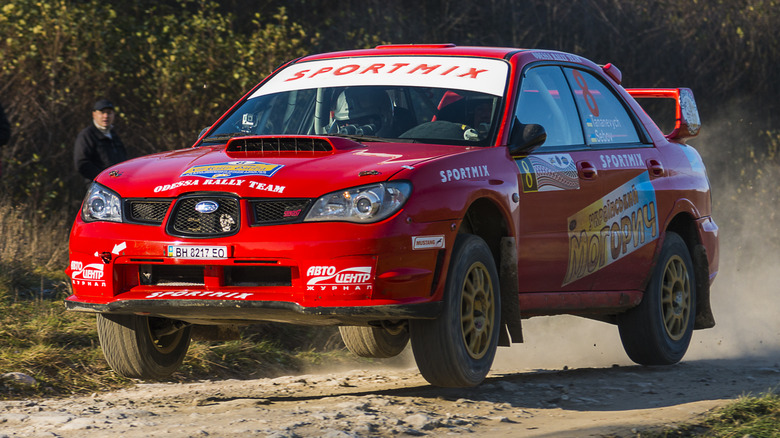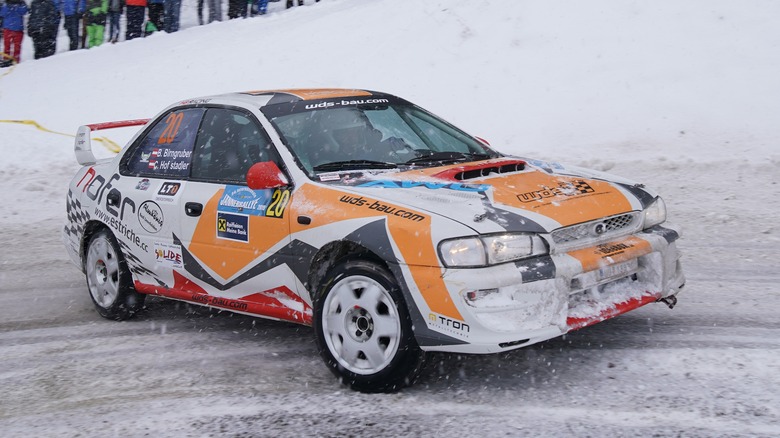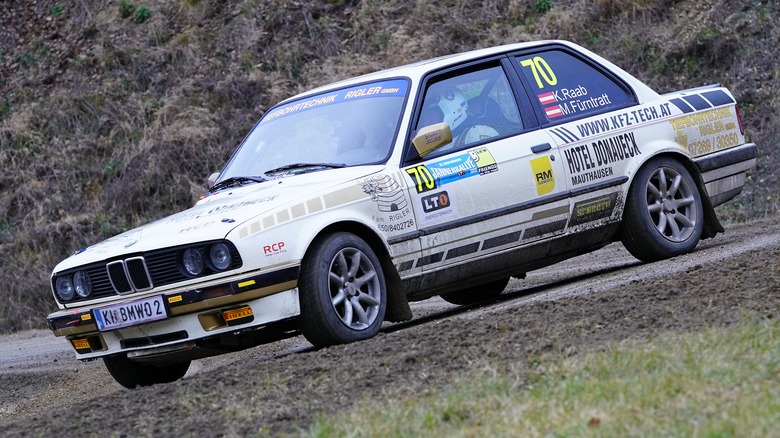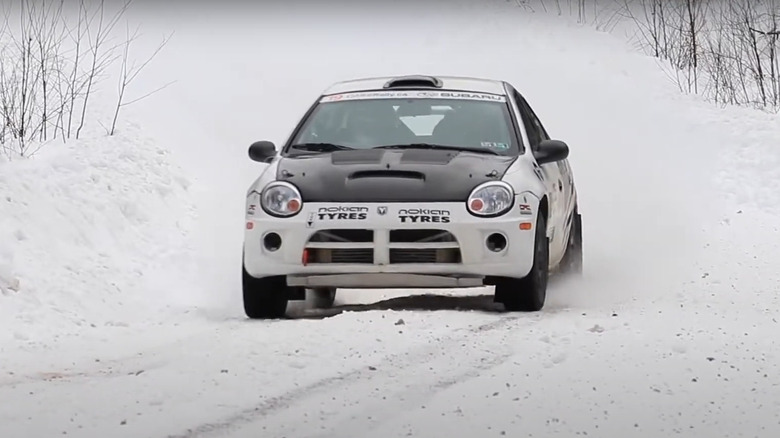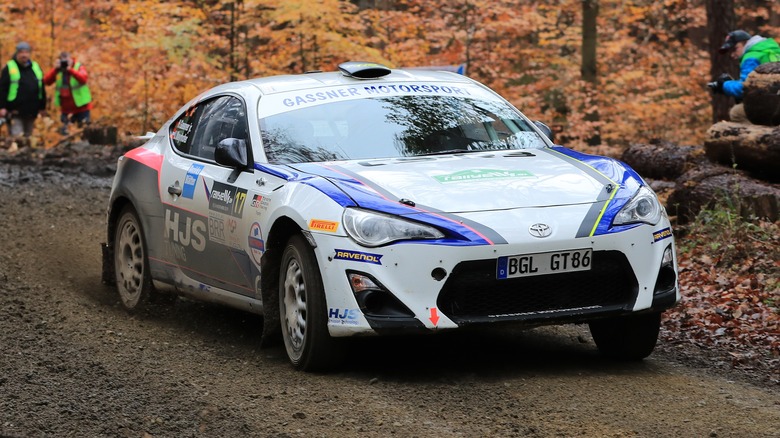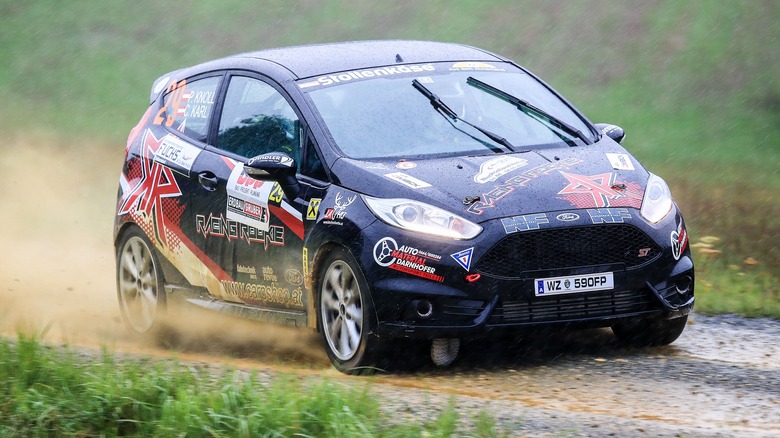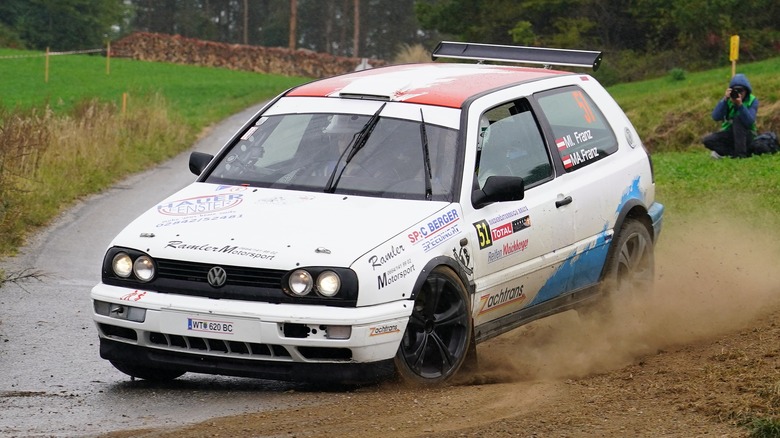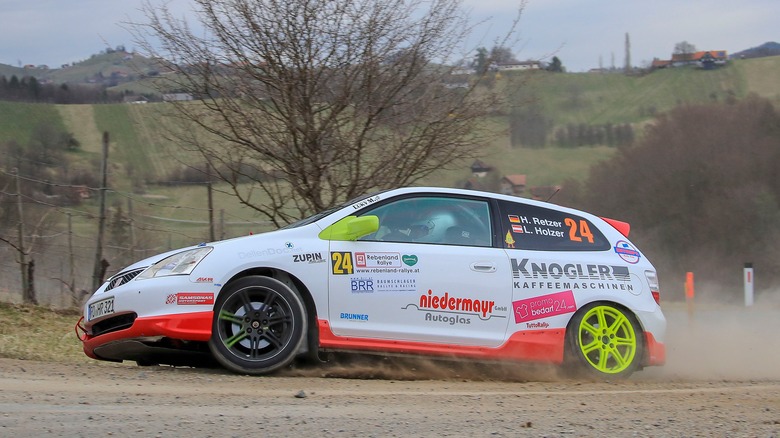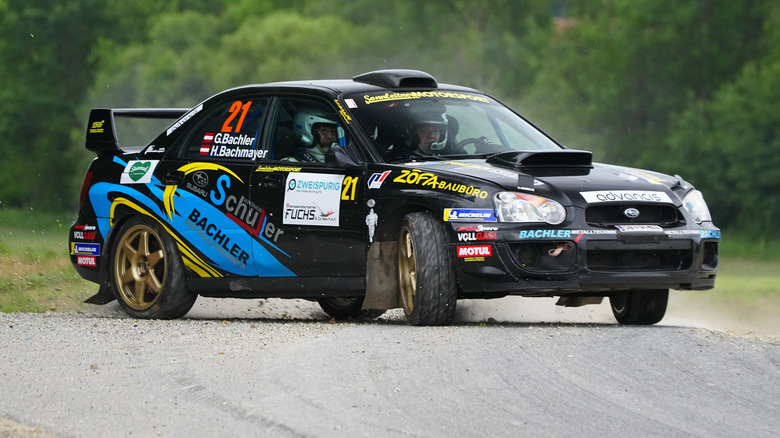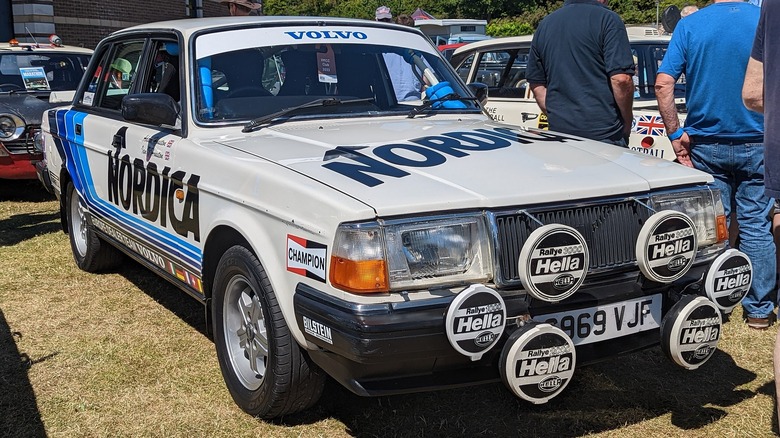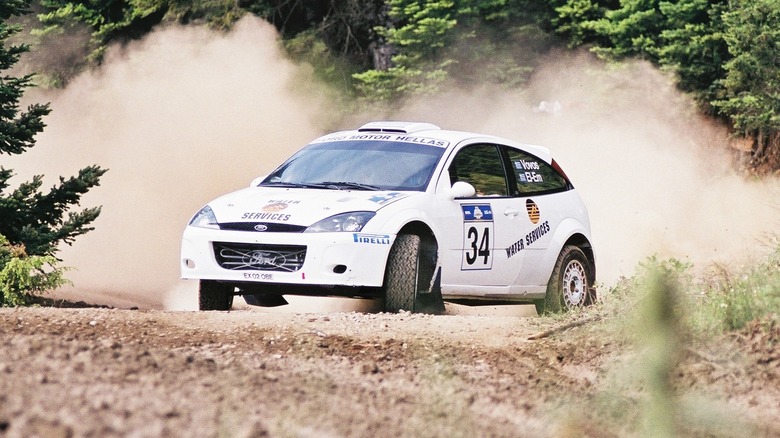10 Of The Best Rally Cars For Beginners
Rallying is one of the oldest forms of motorsport and can trace its origins back to the start of the 20th Century. It continues to enjoy high levels of popularity across all levels of the sport, from the elite World Rally Championship to locally organized grassroots events. The latter category is equally important as the former. While it's great to watch million-dollar cars barrel down the winding roads of Monte Carlo, entry-level rallying's accessibility is what helps differentiate it from other popular forms of motorsport.
It's entirely possible to go rallying on a shoestring budget, provided drivers are careful about what cars they choose. As a general rule of thumb, it's best to buy something cheap, easy to work on, and easy to find for sale in decent condition. It's also important to make sure a steady supply of parts for the car is available, as crashes are an inevitable part of the sport. Before taking the plunge, it's also worth checking with an area's local rallying organization about rules and regulations. Different organizations will have varying safety regulations and class restrictions, but talking to local enthusiasts is also a great way to get tips on what cars are best for local stages.
It can sometimes be cheaper to scour the classifieds for a used rules-qualifying car before building one, but if you're set on building your own rally monster, these 10 popular models are a great place to start.
Subaru Impreza (GC8)
Subaru Imprezas are one of the most common cars to see at rally events, and for good reason. The earliest GC generation can be bought cheaply, and in naturally aspirated form, it makes a great entry point for beginners looking to learn the basics of all-wheel drive rallying. In general, many grassroots drivers recommend opting for naturally aspirated over turbocharged, especially at first. Not only will the car's power be more manageable, but it should also be cheaper and easier to fix should something go wrong.
A great way to start any rally car project is by finding build threads online. Build threads are often filled with helpful advice on what to do and what not to do when preparing the car, and can highlight any problems common to a particular vehicle. Due to the Impreza's long-standing popularity with the grassroots rally crowd, there are plenty of build threads out there detailing various rally setups and common issues. Parts are also widely available, and there's a large aftermarket around the car for anyone looking to upgrade their ride later down the line.
BMW 3 Series (E30)
Affordable examples in good condition might be more difficult to find these days, but the E30 3 Series makes a great base for rally builds if you can source a clean one. It's older and easier to work on than the E36 or E46, plus with fewer electronics onboard, there's less that can go wrong. Both coupe and sedan variants of the E30 make good rally cars, although some owners have pointed out on forums that the sedan is the more practical option for carrying gear to and from events.
While BMW's running costs are generally more expensive relative to other cars, used parts can still be purchased without breaking the bank. Much like buying any older car, it's generally best to buy the cleanest example you can afford, as the more time you spend dealing with rust and mechanical issues, the longer it'll take before the car is ready to go rallying.
Dodge Neon
The front-wheel drive Dodge Neon is a cheap and readily available option, although it's worth watching out for excessive rust on older examples. In stock form, it has a few key weaknesses too — axles are reported to be a common failure point — so it's worth stocking up on spares. The Neon is not only inexpensive, but its parts can also be found on the cheap. Like any rally car, it'll need to be stripped out and race-prepped before it's competitive, not least because it's heavier than many of its rivals in stock form.
It also lacks the cachet of rally favorites like the Impreza, but it can be fast in the right hands. Since it's less likely that drivers will find one at a local event, sourcing knowledge online about where to find the best aftermarket parts will likely be doubly important here. Finding a Neon SRT-4 for sale in decent condition is not as easy as it once was, but the added power will come in handy for drivers looking for the fastest stage times.
Toyota 86/Subaru BRZ
For drivers with a little more upfront capital to spend, the Toyota 86/Subaru BRZ twins make a great choice for all kinds of motorsport duty, including rally. They're a popular choice for leading rally schools like DirtFish, who run their BRZs at factory power output, with upgrades focused around the suspension, engine mounts, and interior. Like any good rally car, they also fit rally wheels and tires and add extra protection in areas most prone to damage, but overall, their overhaul is less extensive than it might first appear.
Alongside the professionals, the 86/BRZ is also a popular choice for amateur racers, with its wide aftermarket being particularly useful. It's always better to fit off-the-shelf aftermarket parts where possible, as custom fabrication is both costly and time-consuming. As the car has gotten older and more wrecked examples hit the scrapyard, it's become easier to find cheap OEM parts too.
Ford Fiesta ST
Another newer option for those with more generous budgets is the Ford Fiesta ST. The front-wheel drive hot hatch lends itself well to rally conversion, with upgraded mechanical and body parts both readily available from the aftermarket. However, with the basic upgrades completed (things like suspension and roll cage), drivers report that most of the car's stock components are tough enough to start the learning process with. This is, after all, a car designed with hard driving in mind, as the many beaten-up examples on the market prove.
While newer cars won't suffer from the same age-related issues as some of the older options above, it's always worth checking for signs of abuse from a previous owner. A rally car will lead a tough life once it reaches the start line, but any hidden issues that crop up during the build process will likely mean a longer build time before it's ready to race.
Volkswagen Golf (Mk3)
The VW Golf is another popular choice at grassroots events, which means it should be easier to find knowledgeable people to assist with building questions and driving tips. It's harder to find parts for older Golf models, but a Mk3 or Mk4 offers a balance between affordability and availability. It also shares parts with other popular VW models, lessening the cost of OEM parts.
While not everyone will want to learn to rally a front-wheel drive car, they are generally easier and cheaper to run than all-wheel drive, and can be just as fast as rear-wheel drive with a skilled driver. It's also a great way to learn more about car control, especially for beginners with little to no prior motorsports experience. Most front-drive cars, including the Golf, aren't particularly powerful in stock form, but that's not necessarily a bad thing — too much power and too little experience can be a recipe for disaster.
Honda Civic
A small, agile hatchback in the same vein as the Golf, the Honda Civic has long been considered a great starting point for a front-wheel drive rally build. The high number of existing rally-spec cars already in competition heralds several advantages. For one, it means it should be easier to find pre-built, ready-to-race examples. As previously mentioned, this can potentially be a lot cheaper than building a car yourself, and it will also cut down on the amount of time between buying the car and getting behind the wheel.
There's also plenty of information on motorsports forums from Civic owners, who can offer valuable wisdom about what to upgrade and which parts to use. The popularity of the Civic also makes it one of the easiest cars to find spare parts for, which, inevitably, will happen sooner or later, especially if you're new to the sport. Whether you just clip a body panel or do some more serious damage to the car, the Civic is one of the most accessible cars to fix up thanks to the high number of junked and cheap used examples.
Subaru Impreza (GD8)
While GD generation Imprezas aren't quite as cheap to run and fix as their older GC counterparts, they're still a great alternative to the classic Impreza. Plus, it can be easier to find used examples in suitable conditions. The GD generation is another top-rated Subaru model for expert tutors, with Team O'Neil rally school using a fleet of them for teaching students how to get to grips with rally driving.
Much like the GC Impreza and BRZ sports car, the GD benefits from a large amount of aftermarket support, making it easy to plan a rally conversion shopping list using off-the-shelf parts. While doing it yourself is the best way to ensure a build that's exactly to your liking, the enduring popularity of the GD Impreza means that pre-built examples are common sights on rally classifieds. Much like the GC, buying a naturally aspirated example will likely be cheaper and should prove to be more durable than a turbocharged car.
Volvo 240
While it might not seem like the first choice for a rally car, the Volvo 240 is tough, simple to work on, and straightforward to upgrade. Stock Volvos are well known for being able to rack up high mileage without issue, which makes going for an older, cheaper example a safer bet than some rivals. Previous build threads on owners forums detail cars with over 300,000 miles on the clock being run in local rallies without issue.
Perhaps it's no surprise that Volvos tend to make good rally cars. After all, they're built to survive decades on the roads of Scandinavia, home to two of the toughest events on the WRC calendar, Rally Finland and Rally Sweden. While the 240 was never officially entered as a works WRC car, it did see success in other forms of motorsport, with the Turbo variant winning the European Touring Car Championship and the DTM in 1985.
[Featured image by Calreyn88 via Wikimedia Commons | Cropped and scaled | CC BY-SA 4.0]
Ford Focus
Another car with a racing pedigree is the Ford Focus. Unlike the Volvo 240, said pedigree came directly from the highest echelon of rallying. The Focus WRC first debuted in competition in 1999 and continued to be used until 2011, when it was replaced with the Fiesta hatchback. Later generations of the Focus weren't sold in America, but the first generation was, and can be found cheap on the used market. It's most commonly found in grassroots rallies across Europe, but a few builds are run in U.S. local events too.
As with any 20+ year-old car, there are a few age-related issues to watch out for. The durability of parts also varies between model years, so it's worth consulting rally forums to get up to speed on the peculiarities of any particular Focus on your shopping list. As ever, building a rally car is much easier with the input of more experienced builders. Before even considering purchasing any of the project cars here, it's worth familiarizing yourself with your local rallying organization and attending some events.
[Featured image by Nickgleris via Wikimedia Commons | Cropped and scaled | CC BY-SA 4.0]
